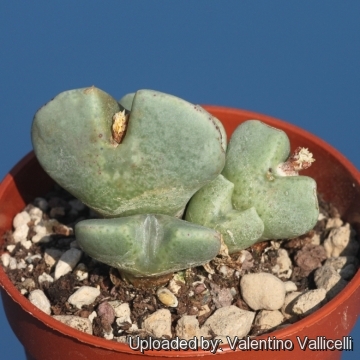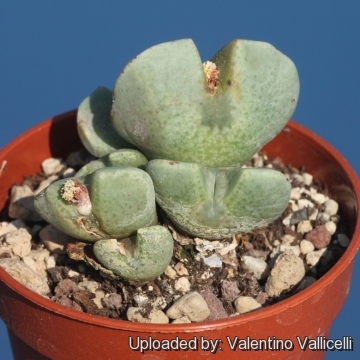Accepted Scientific Name: Conophytum quaesitum (N.E.Br.) N.E.Br.
Gard. Chron. III, 72: 83 1922

Mesembryanthemum quaesitum (Conophytum quaesitum) Photo by: K.k. Agrawal
Origin and Habitat: South Africa (northern Cape Province, Southern Namibia)
Synonyms:
See all synonyms of Conophytum quaesitum
Common Names include:
RUSSIAN (Русский): Конофитум
Description: Conophytum quaesitumSN|25116]]SN|25116]] is a dwarf compact ground-cover succulent with bi-lobed light green bodies. It is not sunken, heavily branched and grows in tight large mats or clusters. It's another very variable species with leaves varying in size, shape and in flower colour.
Stem: Stemless or with very short stems with time.
Bodies (paired leaves): Obovoid with leaf-tips (lobes) incompletely fused long to rather short and beak-like, gaping. The epidermis is pale-green and , sometimes minutely hairy, usually at least faintly spotted with green or maroon spots. During the summer season, plants aestivate and the body is gradually replaced by a new young pair of leaves.
Flowers: Small, nocturnal, white to cream or pinkish, heavily scented and thus attracting night-flying insects especially moth (phalaenophilous).
Blooming season: The flowers are autumnal.
Fruit: Hygrochastic seed capsules 4–6-locular that usually remain on the plant, but strong winds can dislodge and blow them over considerable distances.
Notes: Plants of the genus Conophytum are also known as 'living pebbles'. During the rest period (the summer months in Europe) a new body forms inside the old, gradually taking all the substances from it until all that remains is the skin, which dries and protects the young plant from the heat of the sun and excess evaporation of water. The resting Conophytum protected by this dry cover resembles a pebble and hence the name 'living pebble'. The growth period of most species is from August to March. The temperature should be about 10 to 12°C.
Bibliography: Major references and further lectures
1) James Cullen, Sabina G. Knees, H. Suzanne Cubey “The European Garden Flora Flowering Plants: A Manual for the Identification of Plants Cultivated in Europe, Both Out-of-Doors” Cambridge University Press, 11/Aug./2011
2) Raimondo, D., von Staden, L., Foden, W., Victor, J.E., Helme, N.A., Turner, R.C., Kamundi, D.A. and Manyama, P.A. 2009. “Red List of South African Plants.” Strelitzia 25. South African National Biodiversity Institute, Pretoria.
3) Hammer, S. 1993. “The Genus Conophytum - A Conograph.” Succulent Plant Publications, Pretoria.
4) Hammer, S. 2002. “Dumpling and His Wife: New Views of the Genus Conophytum.” East Anglia Engraving Creative Colour Ltd, Norwich, England.
5) Matlamela, P.F. & Kamundi, D.A. 2006. Conophytum quaesitum (N.E.Br.) N.E.Br. subsp. quaesitum var. quaesitum. National Assessment: "Red List of South African Plants" version 2013.1. Accessed on 2014/01/28
6) Loots S. "Red Data Book of Namibian plants." Southern African Botanical Diversity Network Report No. 38. SABONET, Pretoria and Windhoek. 2005
 SB2153 Namusberge, South Namib, South Africa (Conophytum quaesitum) Photo by: Valentino Vallicelli
SB2153 Namusberge, South Namib, South Africa (Conophytum quaesitum) Photo by: Valentino Vallicelli - SB2153 Namusberge, South Namib, South Africa (Conophytum quaesitum) Photo by: Valentino Vallicelli
- SB2153 Namusberge, South Namib, South Africa (Conophytum quaesitum) Photo by: Valentino VallicelliCultivation and Propagation: Conophytum quaesitumSN|25116]]SN|25116]] is a "winter" grower which is most active from late winter until later spring and heading for summer dormancy, but in favourable growing conditions it keeps going over the summer too and doesn't need particular care. All the forms of Conophytum quaesitumSN|25116]]SN|25116]] are easy to grow.
Soil: Requires good drainage as it it is prone to root rot. It can grows outdoor in sunny, dry, rock crevices (protection against winter wet is required) It can also be cultivated in alpine house, in poor, drained soil.
Watering: It requires little water; otherwise its epidermis breaks (resulting in unsightly scars). Water minimally in summer, (only when the plant starts shrivelling), but it will generally grow even in summer if given water. Water regularly in winter after the previous year's leaves have dried up. Requires good drainage.
Fertilization: Feed it once during the growing season with a fertilizer specifically formulated for cactus succulents (poor in nitrogen), including all micro nutrients and trace elements diluted to ½ the strength recommended on the label. It thrives in poor soils and need a limited supplies of fertilizer to avoid the plants developing excess vegetation, which is easily attacked by fungal diseases.
Exposure: Keep cool and shaded in summer, it needs full sun or light shade.
Temperature: Hardy to -2°C. Ensure a very good ventilation.
Repotting: Avoid to repot frequently. This plant may stay in the same pot for many years.
Uses: Container, rock garden.
Pests and diseases: It is vulnerable to mealybugs and rarely scale.
Propagation: It can be reproduced both by cuttings and seeds. Take the cutting from a grown-up mother plant. Each cutting must contain one or more heads along with a fraction of root. It is easily propagated by seed. The small seeds can be sown in pots of fine, well-drained sand, any time during the spring and summer months when temperatures are warm. Cover the seeds with a very fine layer of grit and water from below with a fungicide to prevent damping off. For the first 3-4 days cover the pots with a sheet of glass/clear perspex to keep the humidity levels high. Remove the glass and replace it with light shadecloth and mist once or twice a day for the next two weeks after which most seeds should have germinated. From then on mistings can be reduced to every second and then every third day as the little plants grow.












